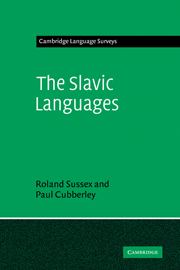Book contents
- Frontmatter
- Contents
- Preface
- Acknowledgments
- map
- 0 Introduction
- 1 Linguistic evolution, genetic affiliation and classification
- 2 Socio-historical evolution
- 3 Phonology
- 4 Morphophonology
- 5 Morphology: inflexion
- 6 Syntactic categories and morphosyntax
- 7 Sentence structure
- 8 Word formation
- 9 Lexis
- 10 Dialects
- 11 Sociolinguistic issues
- Appendix A: Abbreviations
- Appendix B: Orthography and transliteration
- Appendix C: Slavic linguistics: resources
- Bibliography
- Index
8 - Word formation
Published online by Cambridge University Press: 22 September 2009
- Frontmatter
- Contents
- Preface
- Acknowledgments
- map
- 0 Introduction
- 1 Linguistic evolution, genetic affiliation and classification
- 2 Socio-historical evolution
- 3 Phonology
- 4 Morphophonology
- 5 Morphology: inflexion
- 6 Syntactic categories and morphosyntax
- 7 Sentence structure
- 8 Word formation
- 9 Lexis
- 10 Dialects
- 11 Sociolinguistic issues
- Appendix A: Abbreviations
- Appendix B: Orthography and transliteration
- Appendix C: Slavic linguistics: resources
- Bibliography
- Index
Summary
Types of word formation
Slavic stands between Germanic and Romance in its utilization of word formation. It does not share the long compound nouns found especially in German technical vocabulary, or to some extent in phrasal expressions like ‘post-hostage resolution crisis’ in some English professional styles. On the other hand, Slavic as a whole does not follow the analytic tendencies of the Romance languages, which prefer coding compound nouns as phrases.
In Slavic there are rich resources of word formation. For example, the root pis- ‘write’ forms prefixed (Slk podpis ‘signature’, pod ‘under’) and suffixed derivatives (Slk písmeno ‘letter (of the alphabet)’, písomný ‘written, writing’ [Adj]). There are productive patterns of root-combination in nouns (Slk zem ‘earth’, zemepis ‘geography’). Word formation is both a key component of the exploitation of roots in different parts of speech, and a major source of lexical renewal and development (chapter 9).
The scope of word formation includes prefixation, root combination and suffixation other than inflexional suffixation (endings: chapter 5). Word formation overlaps with morphophonology (chapter 4), since the form of roots and affixes may be affected by the combinatorics of derivation. It overlaps with inflexional morphology (chapter 5), since it is concerned with the combination of roots and affixes, an area where the formation of verbal aspect spans both inflexion and word formation. It overlaps with syntax (chapter 7), since word combinations, and particularly the combinations of word-roots, share with syntax major patterns like Modifier + Head (Marchand, 1969; Selkirk, 1982).
- Type
- Chapter
- Information
- The Slavic Languages , pp. 421 - 471Publisher: Cambridge University PressPrint publication year: 2006
- 1
- Cited by

